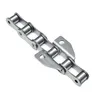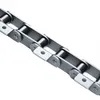Conveyor chains are essential components in material handling systems, designed to move products or materials efficiently along a production line. They consist of interconnected links that form a continuous loop, driven by sprockets to transport items across various industrial settings. These chains are built to withstand heavy loads, high speeds, and harsh environments, making them ideal for applications in manufacturing, packaging, agriculture, mining, and logistics. Available in diverse materials, sizes, and configurations, conveyor chains ensure reliability and durability in operations, reducing downtime and maintenance costs. Key features include corrosion resistance, high tensile strength, and customization options to meet specific industry needs.
Conveyor chains come in several types, each suited for different applications:
Understanding the specifications of conveyor chains is crucial for selecting the right product. Below is a detailed table of common parameters:
| Parameter | Description | Typical Values |
|---|---|---|
| Pitch | The distance between the centers of two adjacent pins, affecting chain flexibility and load capacity. | 0.5 inch to 4 inches |
| Material | The composition of the chain, influencing strength, corrosion resistance, and temperature tolerance. | Stainless steel, carbon steel, plastic, alloy steel |
| Tensile Strength | The maximum load the chain can withstand without breaking, measured in pounds or newtons. | 5,000 lbs to 50,000 lbs |
| Working Load | The safe operational load limit for continuous use, typically lower than tensile strength. | 1,000 lbs to 20,000 lbs |
| Chain Width | The overall width of the chain, important for fitting into conveyor systems. | 1 inch to 12 inches |
| Temperature Range | The operating temperature limits, crucial for environments with extreme heat or cold. | -40°F to 500°F (-40°C to 260°C) |
| Lubrication | Requirements for reducing friction and wear; some chains are self-lubricating. | Oil, grease, or dry lubrication |
Conveyor chains are versatile and used across various industries:
What factors should I consider when choosing a conveyor chain?
Consider the application environment, load capacity, speed, material compatibility, and maintenance requirements. For instance, in corrosive environments, stainless steel chains are preferable, while high-speed applications may require roller chains with minimal friction.
How often should conveyor chains be maintained?
Maintenance frequency depends on usage intensity and environment. Generally, inspect chains every 3-6 months for wear, lubrication needs, and tension. Heavy-duty applications might require monthly checks to prevent failures.
Can conveyor chains be customized for specific needs?
Yes, many manufacturers offer customization in terms of size, material, pitch, and attachments. This allows chains to fit unique conveyor designs and handle specialized materials efficiently.
What are common signs of conveyor chain wear?
Look for elongation beyond acceptable limits (usually over 2-3% of original length), visible cracks, rust, or increased noise during operation. Regular monitoring helps avoid unexpected downtime.
Are there environmentally friendly conveyor chain options?
Yes, plastic chains or those made from recyclable materials are available. They reduce environmental impact and are often used in industries like food processing where cleanliness is paramount.
How do I calculate the required chain length for my conveyor system?
Measure the distance between the drive and tail sprockets, account for sag and tension, and add links for adjustment. Use the formula: Chain Length = (2 × Center Distance) + (Number of Teeth on Sprocket × Pitch) / 2, but consult manufacturer guidelines for accuracy.


